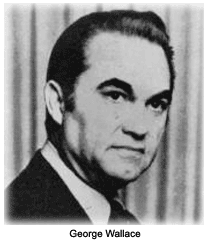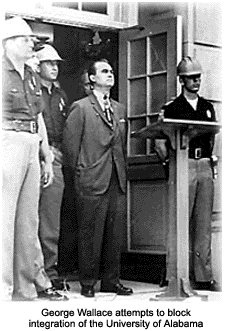 George Wallace was the governor of Alabama in the Sixties, Seventies, and Eighties, who held the dubious distinction of being one of America's most outspoken supporters of racial segregation. As governor, he fought integration, standing symbolically in the doorway of the University of Alabama to block two black students from enrolling there.
Wallace also ran for president in 1964, 1968, 1972, and 1976.
Childhood and education
George Corley Wallace was born in Clio, Alabama, on August 25, 1919, to George C. and Mozell Smith Wallace. The son of a farmer, Wallace and his siblings attended local schools and spent their spare time helping out on the farm. Wallace was active in sports at Barbour County High School, and won the state Golden Gloves bantamweight championship in 1936 and 1937.
Following graduation in 1937, Wallace enrolled in the University of Alabama Law School. That year, his father died, which severely limited the family’s finances. Wallace overcame the financial hardship and worked his way through law school by boxing professionally, waiting on tables, serving as a kitchen helper, and driving a taxi. He received his degree in 1942.
Early career
Following a brief period in the U.S. Air Force, which ended with a medical discharge, Wallace returned to Alabama and served as an assistant state attorney general.
In 1947, he ran successfully from Barbour County for the state legislature. An effective legislator, he sponsored several bills that were instrumental in boosting Alabama's industrial environment, by attracting more than 100 industries into the state. He also sponsored the GI and Dependents Scholarships Act, which provided college and trade school tuition to children and widows of war casualties.
In 1953, Wallace was elected judge in the Third Judicial Circuit, a position he held until 1959.
The governorship
In 1958, Wallace entered the governor's race, but was defeated by John Patterson by more than 64,000 votes. That thumping forced Wallace to significantly change his socio-political views, to appeal to the state's voters.
Wallace resumed his legal duties and continued to work toward his goal of the governorship. In 1962, he won the gubernatorial election as a staunch segregationist, and promised to defy federal orders to integrate Alabama schools.
Wallace's tenure was marked by social tension. In June 1963, he blocked two black students from entering the University of Alabama, surrendering his position only when President Kennedy federalized the Alabama national guard. Other major incidents that marked his career were racial demonstrations in Birmingham and Montgomery, desegregation of schools in Macon County, and the nationally publicized fire-hose and police-dog incidents of Birmingham.
First presidential campaign
During his first administration, Wallace made his initial political push into the North. In 1964, he entered the presidential primaries in Wisconsin, Maryland, and Indiana, and managed to receive as high as 43 percent of the vote.
George Wallace was the governor of Alabama in the Sixties, Seventies, and Eighties, who held the dubious distinction of being one of America's most outspoken supporters of racial segregation. As governor, he fought integration, standing symbolically in the doorway of the University of Alabama to block two black students from enrolling there.
Wallace also ran for president in 1964, 1968, 1972, and 1976.
Childhood and education
George Corley Wallace was born in Clio, Alabama, on August 25, 1919, to George C. and Mozell Smith Wallace. The son of a farmer, Wallace and his siblings attended local schools and spent their spare time helping out on the farm. Wallace was active in sports at Barbour County High School, and won the state Golden Gloves bantamweight championship in 1936 and 1937.
Following graduation in 1937, Wallace enrolled in the University of Alabama Law School. That year, his father died, which severely limited the family’s finances. Wallace overcame the financial hardship and worked his way through law school by boxing professionally, waiting on tables, serving as a kitchen helper, and driving a taxi. He received his degree in 1942.
Early career
Following a brief period in the U.S. Air Force, which ended with a medical discharge, Wallace returned to Alabama and served as an assistant state attorney general.
In 1947, he ran successfully from Barbour County for the state legislature. An effective legislator, he sponsored several bills that were instrumental in boosting Alabama's industrial environment, by attracting more than 100 industries into the state. He also sponsored the GI and Dependents Scholarships Act, which provided college and trade school tuition to children and widows of war casualties.
In 1953, Wallace was elected judge in the Third Judicial Circuit, a position he held until 1959.
The governorship
In 1958, Wallace entered the governor's race, but was defeated by John Patterson by more than 64,000 votes. That thumping forced Wallace to significantly change his socio-political views, to appeal to the state's voters.
Wallace resumed his legal duties and continued to work toward his goal of the governorship. In 1962, he won the gubernatorial election as a staunch segregationist, and promised to defy federal orders to integrate Alabama schools.
Wallace's tenure was marked by social tension. In June 1963, he blocked two black students from entering the University of Alabama, surrendering his position only when President Kennedy federalized the Alabama national guard. Other major incidents that marked his career were racial demonstrations in Birmingham and Montgomery, desegregation of schools in Macon County, and the nationally publicized fire-hose and police-dog incidents of Birmingham.
First presidential campaign
During his first administration, Wallace made his initial political push into the North. In 1964, he entered the presidential primaries in Wisconsin, Maryland, and Indiana, and managed to receive as high as 43 percent of the vote.
 Prevented by state law from succeeding himself as governor in 1966, Wallace persuaded his wife, Lurleen Wallace, to run in his place. She was the first woman to be elected governor of Alabama. Mrs. Wallace ran with the implicit understanding that she would allow her husband to continue to run the day-to-day operations of the state, and she would be the governor in name only.
Things went as planned until early in her term, Mrs. Wallace was diagnosed with uterine cancer. Despite treatment, she passed away in May 1968, at the height of her husband’s presidential campaign.
Following his wife's death, Wallace remarried twice. In 1971, he wedded Cornelia Ellis Snively, a niece of former Alabama governor James E. Folsom. The couple divorced in 1978. In 1981, Wallace married Lisa Taylor, a country music singer. That relationship ended in 1987.
Second presidential campaign
In 1968, as a leading opponent of the civil-rights movement, Wallace campaigned for president on a third-party ticket, while capitalizing on the racist and anti-Washington attitudes in both the North and South.
In 1970, he was elected governor of Alabama. In 1972, he once again declared himself a presidential candidate and entered the Democratic primaries.
With the third campaign — disaster
On May 15, 1972, while campaigning in Laurel, Maryland, Wallace was shot four times by would-be assassin Arthur Herman Bremer. The attempt left him paralyzed below the waist, and abruptly ended his campaign.
Investigation into the shooting found that Bremer's act was not motivated by politics, but by a yen to become famous.
Fourth and final try
In 1974, Wallace was overwhelmingly reelected as governor, and in 1976, he made his fourth and final bid for the Democratic presidential nomination. His campaign was plagued by voters' concerns about his health, as well as the media's constant use of images of his apparent helplessness.
After losing several Southern primaries to former Georgia governor Jimmy Carter, Wallace dropped out of the race in June 1976, and eventually endorsed Carter.
Redemption
In the late 1970s, Wallace became a born-again Christian, moved to reconcile with African Americans, recant his white-supremacist positions, and call those views wrong. He said that, while once he had sought power and glory, he realized he needed to seek love and forgiveness.
In 1982, Wallace was again elected governor, that time with the support of many in the black community. In his final term as governor, a record number of black Alabamians were appointed to government positions.
Retirement
Upon his retirement in 1987, Wallace became a fixture at a Montgomery restaurant a few blocks from the state capitol. While living with constant pain, he enjoyed a large group of old friends and visiting well wishers. He continued that pastime until a few weeks before his death.
George Wallace died of heart failure in Montgomery, Alabama, on September 13, 1998.
Prevented by state law from succeeding himself as governor in 1966, Wallace persuaded his wife, Lurleen Wallace, to run in his place. She was the first woman to be elected governor of Alabama. Mrs. Wallace ran with the implicit understanding that she would allow her husband to continue to run the day-to-day operations of the state, and she would be the governor in name only.
Things went as planned until early in her term, Mrs. Wallace was diagnosed with uterine cancer. Despite treatment, she passed away in May 1968, at the height of her husband’s presidential campaign.
Following his wife's death, Wallace remarried twice. In 1971, he wedded Cornelia Ellis Snively, a niece of former Alabama governor James E. Folsom. The couple divorced in 1978. In 1981, Wallace married Lisa Taylor, a country music singer. That relationship ended in 1987.
Second presidential campaign
In 1968, as a leading opponent of the civil-rights movement, Wallace campaigned for president on a third-party ticket, while capitalizing on the racist and anti-Washington attitudes in both the North and South.
In 1970, he was elected governor of Alabama. In 1972, he once again declared himself a presidential candidate and entered the Democratic primaries.
With the third campaign — disaster
On May 15, 1972, while campaigning in Laurel, Maryland, Wallace was shot four times by would-be assassin Arthur Herman Bremer. The attempt left him paralyzed below the waist, and abruptly ended his campaign.
Investigation into the shooting found that Bremer's act was not motivated by politics, but by a yen to become famous.
Fourth and final try
In 1974, Wallace was overwhelmingly reelected as governor, and in 1976, he made his fourth and final bid for the Democratic presidential nomination. His campaign was plagued by voters' concerns about his health, as well as the media's constant use of images of his apparent helplessness.
After losing several Southern primaries to former Georgia governor Jimmy Carter, Wallace dropped out of the race in June 1976, and eventually endorsed Carter.
Redemption
In the late 1970s, Wallace became a born-again Christian, moved to reconcile with African Americans, recant his white-supremacist positions, and call those views wrong. He said that, while once he had sought power and glory, he realized he needed to seek love and forgiveness.
In 1982, Wallace was again elected governor, that time with the support of many in the black community. In his final term as governor, a record number of black Alabamians were appointed to government positions.
Retirement
Upon his retirement in 1987, Wallace became a fixture at a Montgomery restaurant a few blocks from the state capitol. While living with constant pain, he enjoyed a large group of old friends and visiting well wishers. He continued that pastime until a few weeks before his death.
George Wallace died of heart failure in Montgomery, Alabama, on September 13, 1998.